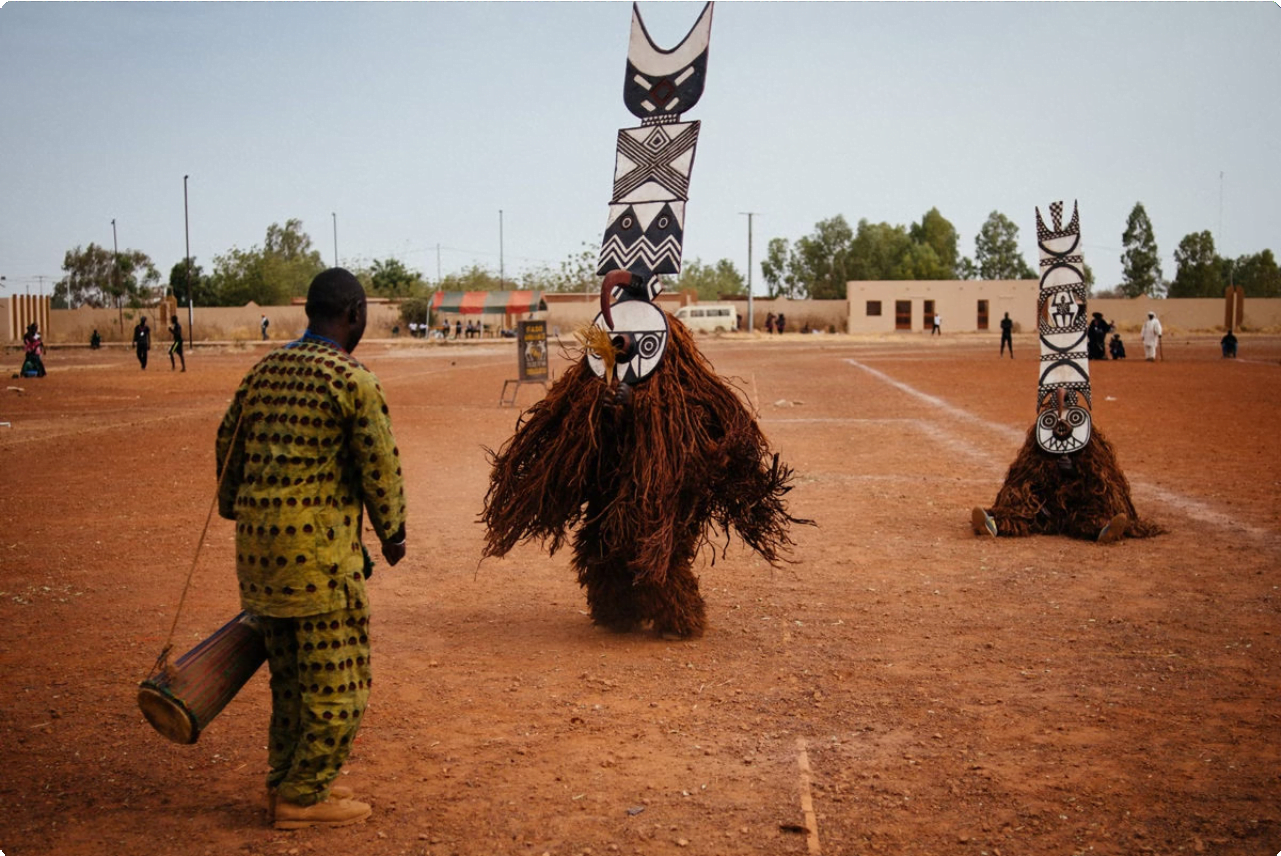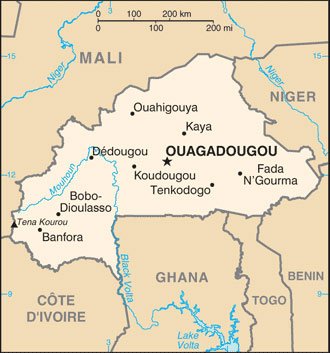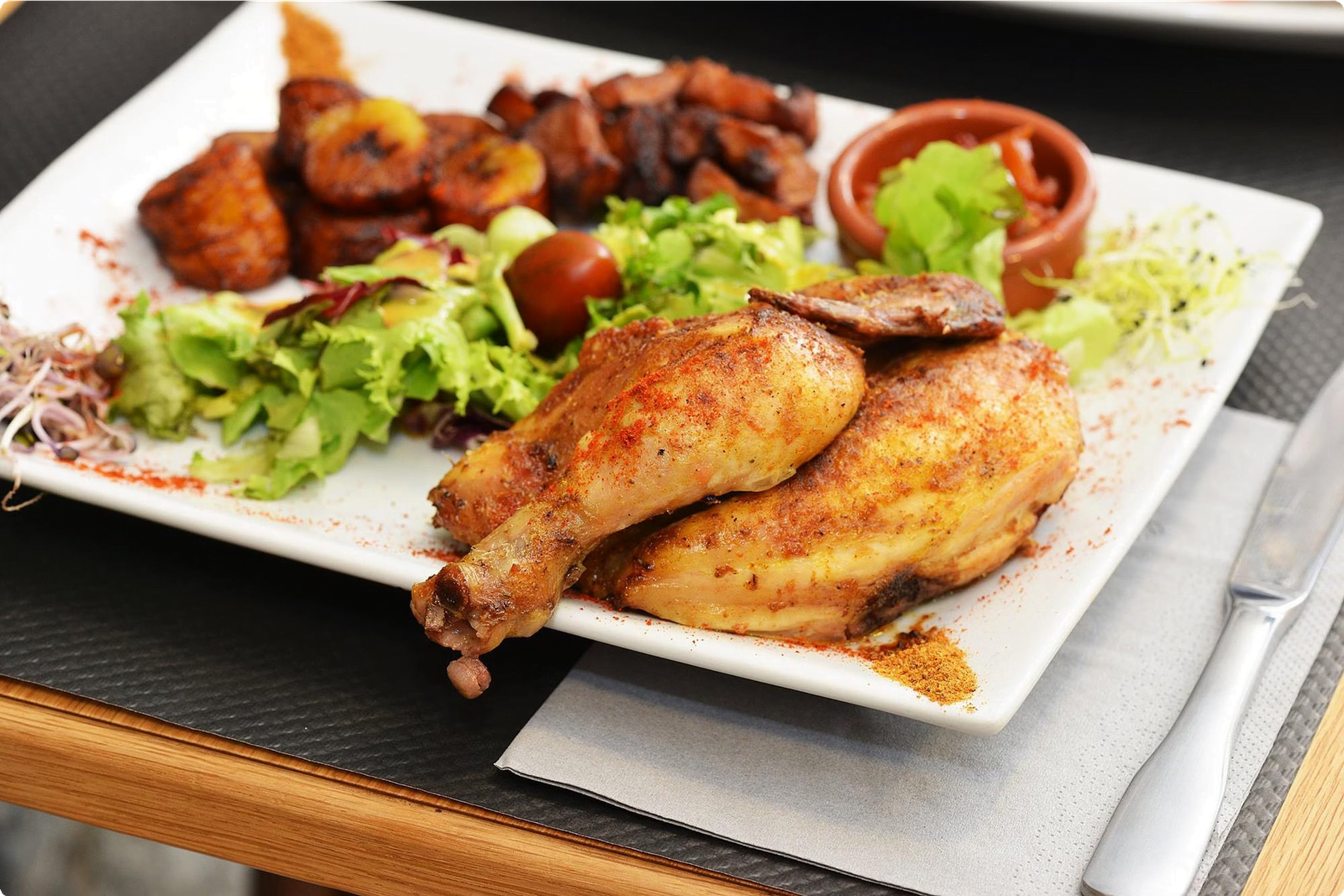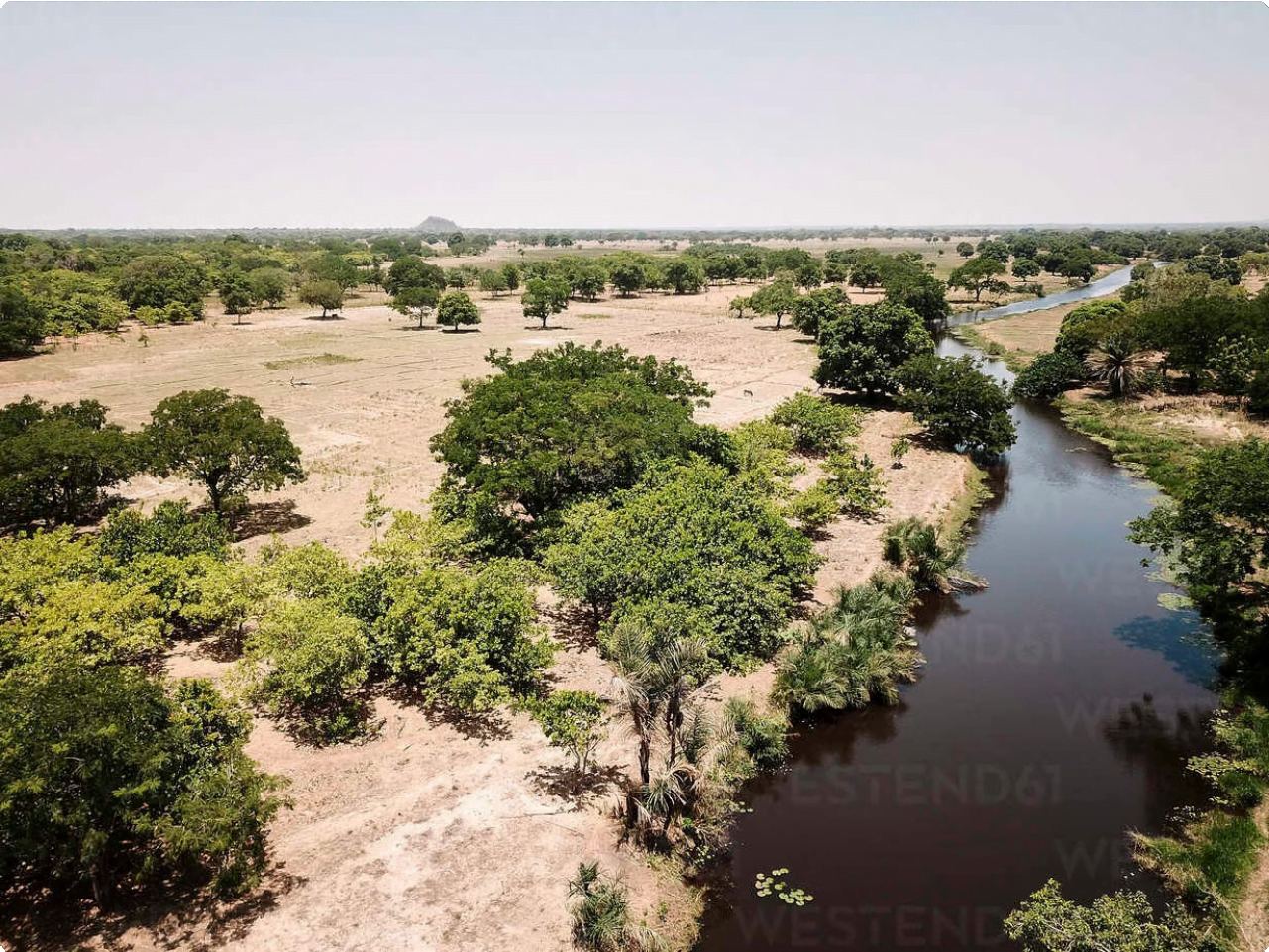Burkina Faso
Discover Burkina Faso
Burkina Faso, a landlocked country in West Africa, is known for its rich culture, diverse ethnic groups, and unique traditions. The name “Burkina Faso” translates to “Land of Honest Men”, reflecting the country’s dedication to authenticity and integrity. Its capital, Ouagadougou, is a vibrant city with bustling markets and colorful festivals.

The country boasts an array of traditional music, dance, and art, influenced by the varied cultural heritage of its people. With a warm and welcoming population, Burkina Faso offers an enriching experience for travelers seeking authentic encounters and meaningful connections.
Location and Geography
Geographical Features
Burkina Faso, a landlocked country in West Africa, is characterized by diverse geographical features. The northern part of the country is dominated by the Sahel region, known for its semi-arid landscapes and sparse vegetation. As we move towards the south, the terrain transitions into savannas and grasslands, creating a visually captivating and ecologically important landscape.
The country is also home to the stunning Banfora Cascades, a series of cascading waterfalls surrounded by lush greenery, and the Sindou Peaks, a cluster of weathered sandstone formations that rise dramatically from the earth. These natural wonders offer visitors a glimpse into the breathtaking beauty of Burkina Faso’s geography.

Rivers and Waterways
Burkina Faso is intersected by several rivers and waterways, including the majestic Volta River, which flows through the southeastern part of the country. The river not only provides vital water resources for the region but also creates picturesque landscapes that are ideal for exploration and eco-tourism.
Additionally, the Nakambé River, also known as the Black Volta, meanders through the southwestern part of the country, contributing to the country’s diverse and striking geography. The presence of these water bodies adds to the allure of Burkina Faso’s natural environment.
Flag and National Symbols
National Flag
The national flag of Burkina Faso consists of two horizontal stripes of red and green, with a yellow star in the center. The red symbolizes the revolution, the green represents the abundance of natural resources, and the yellow star signifies the guiding light of the revolution. The design reflects the country’s struggle for independence and its hope for the future.

Coat of Arms
The coat of arms of Burkina Faso features a shield with two crossed weapons, a spear and a sword, representing the defense of the nation. Behind the shield are two pan-African flags, and above it is a five-pointed star. The coat of arms embodies the spirit of unity, sovereignty, and the pursuit of freedom.
National Symbols
Beyond the flag and coat of arms, Burkina Faso has several national symbols, including the national anthem “Hymne Nationale Volonté,” the national motto “Unité, Progrès, Justice” (Unity, Progress, Justice), and the national flower, the hibiscus. These symbols serve as important representations of national identity and pride.
Currency and Economy
Burkina Faso’s official currency is the West African CFA franc (XOF). The country’s economy is primarily based on agriculture, with cotton being the main export. Additionally, gold mining has become increasingly important to the economy, placing Burkina Faso among the top gold producers in Africa.
The government has placed emphasis on diversifying the economy, with sectors such as tourism and renewable energy gaining traction in recent years.
The country faces challenges such as poverty, lack of infrastructure, and vulnerability to climate change. Efforts are being made to address these issues through sustainable development initiatives and international partnerships.
Major cities and tourist destinations
Ouagadougou
Ouagadougou, the capital city of Burkina Faso, is a vibrant and lively metropolis known for its bustling markets, lively nightlife, and rich cultural heritage. Visitors can explore the Grand-Marché, a sprawling market offering a wide array of local goods and crafts, or visit the National Museum of Music to learn about traditional Burkinabé music. The city also offers a range of delicious street food, traditional architecture, and colorful street art.

Bobo-Dioulasso
Bobo-Dioulasso, the second-largest city in Burkina Faso, is renowned for its impressive mosques, bustling markets, and lively atmosphere. Visitors can explore the historic Dioulassoba Mosque, a striking example of Sudanese-style architecture, or wander through the vibrant Bobo Central Market, known for its handicrafts and textiles. The city also hosts the annual Maure Festival, a traditional celebration of the Bobo people.

Banfora
Nestled in a lush, tropical landscape, Banfora is a picturesque town famous for its stunning natural attractions, including the cascading Karfiguéla Waterfalls and the enchanting Niansogoni Sacred Forest. Adventure seekers can embark on a boat tour of the Tengrela Lake to spot hippos and diverse bird species, while nature enthusiasts can trek through the Sindou Peaks and explore the unique rock formations.

Ouagadougou
Ouagadougou, the capital city of Burkina Faso, is a vibrant and bustling metropolis with a unique blend of traditional African culture and modern urban development. The city is known for its lively markets, colorful festivals, and rich history.
Visitors can immerse themselves in the local culture by exploring the Grand Marché, a bustling market offering a wide array of goods including traditional crafts, textiles, and fresh produce. The Moro-Naba Palace, a symbol of the city’s heritage, is a must-visit for history enthusiasts.
Ouagadougou is also a hub of arts and entertainment, with venues like the National Museum housing an impressive collection of Burkinabè artifacts and contemporary art. The city comes alive with the biennial Pan-African Film and Television Festival, FESPACO, attracting filmmakers and cinema enthusiasts from around the world.
Bobo-Dioulasso
Bobo-Dioulasso, located in the western part of Burkina Faso, is the country’s second-largest city and a vibrant cultural hub. The city is known for its rich history, traditional architecture, and lively markets. Its colonial-era buildings and bustling streets offer a glimpse into the region’s past and present.
The Grand Mosque, a masterpiece of Sudano-Sahelian architecture, stands as a symbol of Bobo- Dioulasso’s heritage and religious significance. Visitors can explore the mosque’s intricate design and serene surroundings, offering a unique blend of spirituality and architectural marvel.
The city is also renowned for its lively music scene, with traditional performances and modern influences blending seamlessly. The Bobo-Dioulasso International Art and Craft Fair attracts artisans and visitors from around the world, showcasing the city’s commitment to preserving and celebrating traditional art forms.
Bobo-Dioulasso’s warm and welcoming atmosphere, coupled with its diverse cultural tapestry, makes it a must-visit destination for travelers seeking an authentic and immersive experience in Burkina Faso.
Banfora
Banfora is a picturesque city located in southwestern Burkina Faso, known for its stunning natural beauty and attractions. One of the most famous landmarks in Banfora is the Karfiguéla Waterfall, where visitors can enjoy the breathtaking sight of cascading water amidst lush greenery. The city is also home to the stunning Tengréla Lake, a serene and tranquil spot perfect for relaxation and picnics.
Travelers to Banfora can explore the Sindou Peaks, a range of rocky formations that offer panoramic views of the surrounding landscape. The Dômes de Fabedougou, ancient dome-shaped rocks, are another unique natural wonder worth visiting. Additionally, the city is a gateway to the Sindou Domes Natural Reserve, providing opportunities for hiking and wildlife viewing.
Rich in culture and history, Banfora is also known for its vibrant local markets, where visitors can experience traditional Burkinabé life and purchase authentic handicrafts and local produce. The warm and welcoming community adds to the charm of this remarkable city, making it a must-visit destination for travelers exploring Burkina Faso.
Gaoua
Gaoua is a city located in the southwest of Burkina Faso, known for its rich history and vibrant culture. The city is the capital of the Poni Province and is home to the Lobi people, known for their unique traditional architecture and strong sense of community.
The city is also famous for its annual mask festival, where intricately crafted masks are worn during traditional ceremonies, showcasing the creativity and skill of the local artisans. Gaoua’s bustling markets offer a kaleidoscope of colors and local handicrafts, providing visitors with a glimpse into the daily life and traditions of the region.
The surrounding countryside is dotted with ancient ruins and sacred sites, offering opportunities for archaeological exploration and immersing in the mystical history of the area. Gaoua provides an authentic experience of Burkina Faso’s cultural tapestry, making it a must-visit destination for travelers seeking to delve into the country’s heritage.
Tiébélé
Tiébélé is a traditional Kassena village located in southern Burkina Faso, known for its exceptionally decorated, painted houses. The village is famous for its unique architecture, featuring elaborately adorned walls that are meticulously hand-painted with geometric patterns and symbolic designs. Each house represents a piece of living art, showcasing the cultural heritage and artistic prowess of the Kassena people. The vibrant colors and intricate detailing make Tiébélé a visually stunning destination, offering visitors a glimpse into the rich traditions and craftsmanship of the local community.
The remarkable artwork on the walls of the houses expresses the history, spiritual beliefs, and identity of the inhabitants, making Tiébélé a living museum of cultural significance. The village has become a symbol of local pride and preservation, where the tradition of house painting is passed down through generations, fostering a deep sense of belonging and heritage.
Exploring Tiébélé allows travelers to immerse themselves in the authentic customs and artistry of the Kassena people, providing a unique and enriching cultural experience. Visitors can also interact with the friendly locals, gaining insight into their daily lives, traditions, and community values.
Sindou Peaks
The Sindou Peaks are a geological wonder located in the Sindou province of Burkina Faso. These unique rock formations are renowned for their towering sandstone pillars, sculpted by natural elements over millions of years. The peaks stand as a testament to the power of erosion, creating a breathtaking landscape of labyrinthine rock formations that offer an unparalleled opportunity for exploration and photography.
Visitors can embark on guided tours through the labyrinth of towering pillars, marveling at the intricate shapes and formations that have been shaped by wind and water. Each turn reveals a new and awe- inspiring vista, with the play of light and shadow enhancing the surreal beauty of the peaks.
The Sindou Peaks are also of great cultural significance, as they have been a source of inspiration for local folklore and traditions, with tales of mythical creatures and ancient spirits associated with these natural wonders. The area surrounding the peaks is rich in biodiversity, offering a unique opportunity for nature enthusiasts to observe the flora and fauna that thrive in this rugged terrain.
W National Park
Located in the west of Burkina Faso, the W National Park is a UNESCO World Heritage site known for its diverse wildlife and stunning natural landscapes. The park is part of a biosphere reserve that extends into neighboring Niger and Benin, making it a crucial conservation area for the region.
The park is home to a variety of species, including elephants, hippos, warthogs, and numerous bird species. Visitors can explore the park on guided safaris, offering the opportunity to witness these incredible creatures in their natural habitat.
The lush vegetation and winding rivers create a picturesque setting, making the W National Park a paradise for nature enthusiasts and photographers alike. The park’s unique ecosystem and rich biodiversity make it a must-visit destination for anyone seeking an authentic African wildlife experience.
Exploring the park’s rugged terrain and observing the native wildlife is an unforgettable adventure, providing a deeper understanding of the importance of conservation efforts in protecting these natural wonders for future generations.
Culture and traditions
Burkina Faso is rich in diverse cultures and traditions, with 63 different ethnic groups, each with its own unique customs and practices. The people of Burkina Faso are known for their vibrant and colorful traditional clothing, intricate jewelry, and expressive dance forms.
The country is also famous for its traditional music, which often features the enchanting sounds of the balafon, a type of xylophone, and the rhythms of the djembe drum. The Burkinabé people take great pride in their cultural heritage, and traditional ceremonies and rituals play an integral role in their everyday lives.
One of the most celebrated traditions in Burkina Faso is the FESPACO film festival, which is the largest African cinema festival on the continent. This event showcases the talent and creativity of African filmmakers and contributes to the vibrant cultural scene in Burkina Faso.
Ethnic Groups and Languages
Mossi
The Mossi people are the largest ethnic group in Burkina Faso, accounting for more than half of the country’s population. They have a rich history and are known for their skilled craftsmanship in pottery, weaving, and metalwork. The Mossi have their own language, More, which is widely spoken in the central region of the country.
Fulani
The Fulani, also known as Peul, are a nomadic pastoralist ethnic group with a significant presence in Burkina Faso. They are known for their cattle-herding traditions and are often recognized by their colorful traditional attire, including their distinctive conical hats. The Fulfulde language is commonly spoken among the Fulani community.
Bobo
The Bobo people are renowned for their vibrant and expressive musical traditions, particularly the use of the balafon, a traditional wooden xylophone. They have their own language, referred to as Bobo or Bwa, and are known for their striking mud-built homes and unique architectural designs.
Traditional Music and Dance
Vibrant Rhythms
The traditional music and dance of Burkina Faso are characterized by vibrant rhythms that reflect the unique cultural heritage of the various ethnic groups in the country. The music is often accompanied by traditional instruments such as the balafon, djembe, and talking drum, creating a lively and enchanting atmosphere.

Colorful Costumes
During traditional dance performances, the dancers adorn themselves in colorful costumes that represent the cultural identity of their community. Each movement and gesture tells a story, conveying the rich history and traditions preserved through the art of dance.

Cultural Expression
Traditional music and dance in Burkina Faso serve as a powerful form of cultural expression, celebrating the resilience and spirit of the people. These art forms play a central role in social gatherings, ceremonies, and festivals, fostering a sense of unity and identity within the communities.

Cuisine and Local Dishes
Fufu and Soup
Fufu is a staple food in Burkina Faso, made from pounded starchy vegetables like yams, cassava, or plantains. It is often served with a delicious and flavorful soup made from vegetables, meat, and spices. The process of making fufu involves pounding the boiled vegetables to achieve a smooth, dough-like consistency.

Tô and Sauce
Tô is another popular dish, made from millet or sorghum flour. It is cooked to a smooth, thick consistency, and is often served with a variety of sauces made from tomatoes, onions, leafy greens, and protein such as meat or fish. The sauces are rich in flavor and provide a delicious accompaniment to the tô.

Poulet Bicyclette
Poulet Bicyclette, or “bicycle chicken,” is a unique dish featuring free-range chicken reared in the villages. The meat is known for its rich and distinct flavor, often enhanced by marinating in local spices, herbs, and peppers. It is typically grilled or roasted, resulting in tender and flavorful chicken.

Arts and Crafts in Burkina Faso
Traditional Pottery
In Burkina Faso, traditional pottery is highly valued and plays an important role in the cultural heritage. Skilled artisans create unique pottery pieces, often adorned with intricate patterns and vibrant colors. The pottery reflects the traditional techniques and aesthetic sensibilities of the different ethnic groups in the country, making it a captivating aspect of Burkina Faso’s arts and crafts scene.

Bronze Sculptures
The art of bronze sculpture has a rich history in Burkina Faso. Skilled craftsmen use the ancient lost-wax casting technique to create exquisite bronze sculptures depicting various aspects of Burkinabe life, history, and mythology. These sculptures are not only beautiful artworks but also serve as a means of storytelling, preserving cultural narratives through their intricate designs.

Traditional Weaving
Weaving is an integral part of Burkina Faso’s artistic heritage. The country is renowned for its traditional woven textiles, which are skillfully crafted using indigenous materials and techniques. The vibrant colors and intricate patterns of the woven fabrics reflect the cultural diversity and creative expression of the Burkinabe people, making them prized artifacts in the realm of African textile arts.

Festivals and celebrations
- Ouagadougou International Film Festival: This festival, held annually in February, is a vibrant celebration of African and international cinema. It showcases thought-provoking films from diverse cultural backgrounds, featuring engaging discussions and workshops with acclaimed filmmakers.
- La Fête de la musique: Taking place in June, this music festival is a lively event where musicians and music lovers come together to enjoy free performances in the streets, parks, and public spaces across the country. It celebrates the rich musical traditions of Burkina Faso and fosters a sense of community through the universal language of music.
- Moros Y Cristianos Festival: This colorful festival, inspired by local folklore and history, is celebrated in different regions of Burkina Faso. It features vibrant parades, traditional dances, and reenactments of historical events, bringing together locals and visitors to honor their heritage and cultural identity.
Climate and Weather
Burkina Faso experiences a tropical climate with two distinct seasons: the rainy season and the dry season. The rainy season, which lasts from May to October, brings heavy rainfall and high humidity, especially in the southern regions. The dry season, from November to April, is characterized by hot temperatures and clear skies, making it the ideal time for outdoor activities and travel.
The northern part of the country is known for its extreme temperatures, with scorching hot days and cool nights. In contrast, the southern areas are milder and more humid due to the influence of the West African monsoon. Travelers should be prepared for these varying weather conditions when visiting different regions of Burkina Faso.
The average annual temperature in Burkina Faso ranges from 77°F to 91°F (25°C to 33°C), with the hottest months being March and April. It’s advisable to pack lightweight, breathable clothing and sunscreen, especially during the dry season. Additionally, it’s important to stay hydrated and take necessary precautions to avoid heat-related illnesses in the hotter months.
Best Time to Visit
- Dry Season (November to February): The dry season is generally considered the best time to visit Burkina Faso, with pleasant weather and clear skies. It’s an ideal time for outdoor activities and exploring the natural beauty of the country.
- Festival Season (September to October): This period is perfect for experiencing the vibrant culture and traditions of Burkina Faso, with various festivals and events showcasing the rich heritage of the country.
- Shoulder Seasons (March to May, and September to October): These transitional periods offer a mix of favorable weather and cultural activities, making it a good time to visit for those who want to avoid peak tourist seasons.
Travel tips and safety precautions
- Health precautions: When traveling to Burkina Faso, it’s important to be mindful of the health precautions. Make sure to consult a healthcare professional for necessary vaccinations and medications. Carry insect repellent as some areas may have a risk of malaria.
- Personal safety: While Burkina Faso is a relatively safe country, it’s always wise to exercise caution, especially in crowded places and tourist areas. Be mindful of your belongings and avoid displaying expensive items in public.
- Weather considerations: Burkina Faso experiences a hot, semi-arid climate. Travelers should pack appropriate clothing for the weather, including lightweight and breathable fabrics. It’s also essential to stay well-hydrated and protect yourself from the sun.
Transportation options
Public Transportation
Burkina Faso’s major cities like Ouagadougou and Bobo-Dioulasso have public transportation systems consisting of buses and taxis. While buses are the primary mode of transportation, taxis are also widely available for shorter trips within the cities.
Rental Cars
Travelers who prefer flexibility and independence can opt for rental cars. There are various car rental agencies in the major cities, offering a range of vehicles to suit different preferences and budgets.
Motorbike Taxis
In certain areas, especially in rural and smaller towns, motorbike taxis, known as “zemidjans”, are a popular form of transportation. These provide an efficient way to navigate through the bustling streets and access remote locations.
Inter-city Buses
For travelers looking to explore beyond the main cities, inter-city buses offer a convenient and budget- friendly option. These buses connect different regions of Burkina Faso, providing access to a diversity of landscapes and cultural experiences.
Accommodation choices
Luxury Hotels
For travelers seeking a luxurious and pampering experience, Burkina Faso offers a selection of high-end hotels and resorts with spacious rooms, excellent amenities, and top-notch service. Some of these establishments are located in bustling urban centers, while others are nestled in serene natural surroundings, offering a tranquil escape.
Boutique Guesthouses
For those looking for a more intimate and authentic experience, boutique guesthouses are a popular choice. These charming accommodations often feature unique decor, personalized service, and a cozy atmosphere. Many boutique guesthouses are situated in historic buildings, providing an opportunity to immerse in the local culture and heritage.
Eco-friendly Lodges

Travelers with a focus on sustainability and conservation can opt for eco-friendly lodges that are committed to minimizing their environmental impact. These accommodations are typically situated in nature reserves or rural areas, allowing guests to connect with nature while contributing to responsible tourism practices.
Must-see attractions
Ouagadougou Grand Market
The largest and most vibrant market in the capital city, where travelers can experience the bustling atmosphere, shop for unique handicrafts, and soak in the local culture and flavors.
Moro-Naba Palace
A historic and traditional palace that provides insight into the rich history and heritage of Burkina Faso. The stunning architecture and cultural significance make it a must-visit attraction.
Nazinga Game Ranch
Home to a diverse range of wildlife, including elephants, antelopes, and hippos, this expansive ranch offers exciting safaris and opportunities to observe the beauty of Burkina Faso’s natural landscape.
Kompienga Reserve
An ecologically diverse area with picturesque landscapes, including rivers, forests, and wildlife. Visitors can enjoy outdoor activities such as birdwatching, hiking, and boat tours amidst pristine natural surroundings.
Conclusion and Final Thoughts
As we conclude our exploration of Burkina Faso, it’s impossible not to be captivated by the rich tapestry of culture, vibrant traditions, and warm hospitality that the country has to offer. Beyond the bustling cities and breathtaking landscapes, Burkina Faso is a place where history comes alive, and the spirit of its people shines through.

Whether it’s the colorful festivals, delectable cuisine, or the intriguing arts and crafts, the country beckons visitors to immerse themselves in its unique charm. With a blend of traditional and modern experiences, Burkina Faso stands as a testament to resilience, creativity, and the unyielding spirit of its population.
For those seeking an authentic and enriching travel experience, Burkina Faso’s allure is undeniable, promising unforgettable memories that will linger long after the journey has ended.